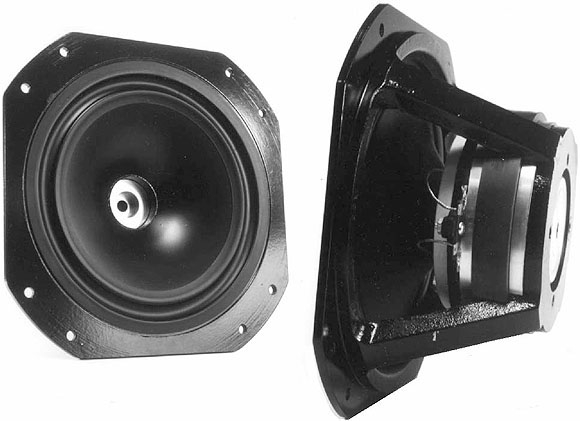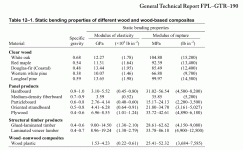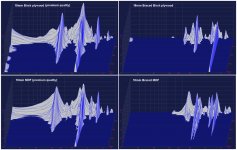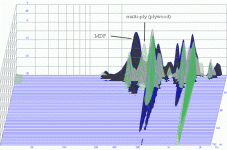Hey guys, I'm about to make a box for 2 sundown sd2s, and I was wondering if I need bracing if I'm already going to double up on the front panel so it'll be 1.5in thick. The box will be about 4.5ft3, so is bracing necessary with a double front panel? If it is, would it matter where I would put one? If I have to, is putting one down vertically thats 4 by .75in in the middle between my subs ok?
What are you building the box out of? A box that large, even if built with quality ply will require bracing to keep it from ballooning. With MDF you'll need much more.
A sealed hole with wires coming out is fine, not as elegant as a cup/binding posts but better sounding.
dave
A sealed hole with wires coming out is fine, not as elegant as a cup/binding posts but better sounding.
dave
For MDF it needs to be almost 2x as thick as quality ply, so you'd have a stiffer/better box if built from 1/2" ply. There should probably not be any unbraced span greater than 8" (can be a long rectangle 8" wide). The braces should reach across the box to the other side. You can greatly reduce the amount of mechanically transmitted energy to the box by mounting the 2 drivers push-push with a rigid connection between them.
dave
dave
thanks, but would I have any serious problems with just the front baffle and a couple braces? I already got one sheet of mdf and I'd rather not put out more money for another sheet since I'm a little tight on cash now. Also what do you mean by mounting them push-push?
Last edited:
Hi Dave,For MDF it needs to be almost 2x as thick as quality ply, so you'd have a stiffer/better box if built from 1/2" ply.
Can you back up your statement with any data?
Did some googling, MDF is typically 3450 MPa, Baltic Birch 9100 MPa (bigger is better), which, in this case, gives an even grater advantage to BB than the GM supplied number of 18mm BB ~ 1 1/4" MDF
Attached is a more generic table from a textbook. You can see that BB is at the top end of the scale.
dave
Attached is a more generic table from a textbook. You can see that BB is at the top end of the scale.
dave
Attachments
Thanks Dan for explaining.
In my view, conclusions based on material characteristics charts are not very useful for this subject. Charts of those properties are based on 'contact vibration' and panels in free field. They don’t represent acoustic properties from a loudspeaker enclosure.
In a study from Jim Moriyasu (AudioXPress, February 2002) for an 8” subwoofer, he tested the same design with different blank panels to construct several enclosures. He measured a 1 to 2dB lower level of primary resonances for MDF compared to plywood. In a study for studio loudspeakers from Any Munro (Munro Acoustics) for Dynaudio Acoustics/Professional (not published but shown at an AES convention) the conclusion was 22mm MDF had similar properties to high quality 25mm (18-layer) Scandinavian plywood for the Dynaudio ABES studio subwoofer. In several AES papers you can find studies as part of research for subwoofers/loudspeakers in which they 'prefer' the acoustic properties of MDF. 99% of all top range studio monitors use MDF. Using an economic factor for their choice would be strange for 50K+ Dollar handcrafted systems.
Anyway, studies may have shown an 1 or 2dB better damping values for MDF, this number becomes even less when proper (supported) braces are used. For that reason you can even build high quality enclosures from (fine) particle board if you know what you are doing. But lets face it, how serious and sexy would your design be received if you are using particle board? When you ask a critic if he ever properly constructed a particle board enclosure and compared it one on one with ply or MDF the answer is... In my view the only motivation why particle board has a bad reputation is because all cheap and bad constructed encloses use it. It doesn't matter much what you are using; mdf, ply or even particle board. However, I do agree with Dan that (supported) braces are not an option...
In my view, conclusions based on material characteristics charts are not very useful for this subject. Charts of those properties are based on 'contact vibration' and panels in free field. They don’t represent acoustic properties from a loudspeaker enclosure.
In a study from Jim Moriyasu (AudioXPress, February 2002) for an 8” subwoofer, he tested the same design with different blank panels to construct several enclosures. He measured a 1 to 2dB lower level of primary resonances for MDF compared to plywood. In a study for studio loudspeakers from Any Munro (Munro Acoustics) for Dynaudio Acoustics/Professional (not published but shown at an AES convention) the conclusion was 22mm MDF had similar properties to high quality 25mm (18-layer) Scandinavian plywood for the Dynaudio ABES studio subwoofer. In several AES papers you can find studies as part of research for subwoofers/loudspeakers in which they 'prefer' the acoustic properties of MDF. 99% of all top range studio monitors use MDF. Using an economic factor for their choice would be strange for 50K+ Dollar handcrafted systems.
Anyway, studies may have shown an 1 or 2dB better damping values for MDF, this number becomes even less when proper (supported) braces are used. For that reason you can even build high quality enclosures from (fine) particle board if you know what you are doing. But lets face it, how serious and sexy would your design be received if you are using particle board? When you ask a critic if he ever properly constructed a particle board enclosure and compared it one on one with ply or MDF the answer is... In my view the only motivation why particle board has a bad reputation is because all cheap and bad constructed encloses use it. It doesn't matter much what you are using; mdf, ply or even particle board. However, I do agree with Dan that (supported) braces are not an option...
Last edited:
It has been 10 years since i read Jim's article, at what frequencies did the back panel resonate? The Q and frequency of the resonace are important, level is meaningless without those.
As to the others there are counter-examples to each & every one of them.
On a sub, as long as you push the (potential) resonances above the operating bandwidth they will not get excited and be, in practice, non-existent (a pretty easy task -- stiff, light material makes it easier to get there) then what you have to worry about is ballooning. Stiffness reigns supreme there.
Can the Munro paper be had?
dave
As to the others there are counter-examples to each & every one of them.
On a sub, as long as you push the (potential) resonances above the operating bandwidth they will not get excited and be, in practice, non-existent (a pretty easy task -- stiff, light material makes it easier to get there) then what you have to worry about is ballooning. Stiffness reigns supreme there.
Can the Munro paper be had?
dave
Hi Dave,
The articles were not my main point besides showing there are enough studies and examples that do not support the 'superior' acoustic characteristics of plywood. However you can find plenty of studies and examples that prove stiffness is more a matter of proper construction. Munro is not known for his 'many' publications but if you e-mail him personally, you might have a chance. Best way to find out these things is talking to acoustic designers for studio's that have to function within 'standards'. These guys all carry a personal (expensive) database of acoustic properties of materials used in all kinds of different constructions (building, enclosures, absorbers ect).
The articles were not my main point besides showing there are enough studies and examples that do not support the 'superior' acoustic characteristics of plywood. However you can find plenty of studies and examples that prove stiffness is more a matter of proper construction. Munro is not known for his 'many' publications but if you e-mail him personally, you might have a chance. Best way to find out these things is talking to acoustic designers for studio's that have to function within 'standards'. These guys all carry a personal (expensive) database of acoustic properties of materials used in all kinds of different constructions (building, enclosures, absorbers ect).
Last edited:
Intuition about bracing is one of those things that comes with an imagination for geometry. Just make sure you are conservative in how you feel about cabinet vibrations (that is, you have to figure the vibrations will be bigger and more harmful than your expect them to be).
It should be pretty intuitive when you have expanses of wall that need bracing.
One brace joining the middle of two opposite cabinet walls can be equivalent to a great many extra mm of wall thickness.
Ben
It should be pretty intuitive when you have expanses of wall that need bracing.
One brace joining the middle of two opposite cabinet walls can be equivalent to a great many extra mm of wall thickness.
Ben
One brace joining the middle of two opposite cabinet walls can be equivalent to a great many extra mm of wall thickness.
Best to not have the brace right in the middle.
I have a pair of subs under evaluation right now, push-push SDX10 sealed made of well braced 15mm BB. Too early to say anything yet.
dave
Isn't it a cryin' shame that drivers don't have bolts on their backside for securing the opposite wall? I've never seen a driver that does or a driver that makes it easy to attach a brace with a giant hose clamp, epoxy, or any way. The rear plate on the driver should/can be strongly attached to the basket and so make it feasible to attach a brace.
True, the opposite wall is traditionally the removable cabinet back, but easy enough to figure ways to secure a brace from the driver backside to a removable cabinet back panel.
Total air-tightness even in a sealed box isn't critical - just one of those compulsive things people on Internet forums like to banter about. For sure, you always need a pin-hole for barometric pressure adjustment. No big thing.
Excuse my ignorance, but when researching the charm of different panel materials, do you want to see the resonance higher or lower? Wouldn't ballooning flexing walls make it lower (and all other freqs where you have ballooning)? But higher where you have some kind of sympathetic vibration at unison or octaves?
Ben
my quickie way to create a low-weight but strong brace is by cutting a length of thin-wall tubing (like for electric mains conduits) and securing with a large blobs of epoxy at each end. Fast and easy to implement a whole bunch that way, if your design has big panels or funny angles (like a triangular corner sealed box).
True, the opposite wall is traditionally the removable cabinet back, but easy enough to figure ways to secure a brace from the driver backside to a removable cabinet back panel.
Total air-tightness even in a sealed box isn't critical - just one of those compulsive things people on Internet forums like to banter about. For sure, you always need a pin-hole for barometric pressure adjustment. No big thing.
Excuse my ignorance, but when researching the charm of different panel materials, do you want to see the resonance higher or lower? Wouldn't ballooning flexing walls make it lower (and all other freqs where you have ballooning)? But higher where you have some kind of sympathetic vibration at unison or octaves?
Ben
my quickie way to create a low-weight but strong brace is by cutting a length of thin-wall tubing (like for electric mains conduits) and securing with a large blobs of epoxy at each end. Fast and easy to implement a whole bunch that way, if your design has big panels or funny angles (like a triangular corner sealed box).
Last edited:
Isn't it a cryin' shame that drivers don't have bolts on their backside for securing the opposite wall? I've never seen a driver that does or a driver that makes it easy to attach a brace with a giant hose clamp, epoxy, or any way. The rear plate on the driver should/can be strongly attached to the basket and so make it feasible to attach a brace.
there are some drivers with a treaded hole in the back plate, but this one is ideal (designed to be bolted to a brace thru the pole piece). Note that the magnet is inside the basket.

PEARL PR-2 Woofer
Excuse my ignorance, but when researching the charm of different panel materials, do you want to see the resonance higher or lower?
I aim for as high a panel resonance as possible. With energy available to excite any (potential) resonance falling with the square of the frequency, so if you can get them high enuff they will not likely ever get excited and it will be as if they do not exist. THis theory has worked very well in practise for me.
Wouldn't ballooning flexing walls make it lower?
Typically a subwoofer box is small compared to the frequencies it produces, so it is easy to push (potential) resonances above the passband. Ballooning is different, and happens when the walls are not strong and stiff enuff to resist being pushed out or pulled in by the change in pressure inside the box.
dave
Thank you, again, Planet10.
My bad. Interesting to hear your take on wall-resonance freq but my puzzlement had to do with the alleged research showing amplitude of output changes (and presumably, we are talking about total box output... drivers and walls). In that case, ballooning versus sympathetic vibration act in opposite ways. In other words, is it more desirable to show the amplitude goes down or the amplitude goes up, say at the box resonant freq?
Ben
My bad. Interesting to hear your take on wall-resonance freq but my puzzlement had to do with the alleged research showing amplitude of output changes (and presumably, we are talking about total box output... drivers and walls). In that case, ballooning versus sympathetic vibration act in opposite ways. In other words, is it more desirable to show the amplitude goes down or the amplitude goes up, say at the box resonant freq?
Ben
Measurements from Martin vd Hoff
Attachments
I'll do you one better, here is an overlay from that study. It will be noticed that ply resonates at higher frequencies. The stuff above 500 hz will likely never get excited, possiblly the one at 500 Hz (ply falls faster than MDF), the big MDF one at the bottom quite likely.

dave
dave
Attachments
- Status
- This old topic is closed. If you want to reopen this topic, contact a moderator using the "Report Post" button.
- Home
- Loudspeakers
- Subwoofers
- Do I need bracing?


